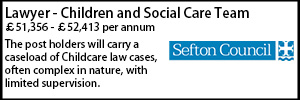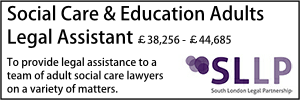Proportionality in adoption cases
- Details
Lisa Edmunds summarises four decisions about proportionality in adoption cases and sets out the takeaway points for everyday practice.
In recent times there haven’t been many family decisions handed down from the Supreme Court. However, in June we had the decision of Re H-W (Children). That decision has been applied in two recent Court of Appeal decisions – one of which was a successful appeal from our local court.
The recent decisions about proportionality in adoption cases, in date order, are:
25.03.2022: Re B (A Child) (adequacy of reasons) [2022] EWCA Civ 407
15.06.2022: Re H-W (Children) (No 2) [2022] UKSC 17
30.06.2022: Re D (A Child: Placement Order) 2022 EWCA Civ 896
06.07.2022: Re CV (A Child) (Placement Order) [2022] EWCA Civ 930
Takeaway points:
- Adoption can only be approved where it is in the child’s lifelong interests and where the severe interference with the right to respect family life is necessary and proportionate.
- A care order must be necessary to meet the needs of the child(ren) having regard to the advantages and disadvantages of each available option.
- The court must have in its possession all the available information that allows a full and reasoned analysis of each realistic placement option.
- In order to be able to decide whether the proposed outcome of adoption is necessary and proportionate, the court has to undertake a number of steps,
- Firstly, it must evaluate the family placement (or other option) and ask itself the following:
- Would the children suffer harm, if so the nature of the harm and the likelihood of the child suffering from that harm?
- What would be the consequences of such harm arising?
- The possibility of reducing or mitigating the risk of such harm.
- Secondly, it must then compare the welfare advantages and disadvantages of the options presented. It is only via this process that a court can validly conclude that the adoption is the only outcome that can provide for the child’s welfare.
- In the absence of the evaluation analysis, which is required, and the guidance in Re B, the court cannot determine whether the orders sought are proportionate and necessary.
- In Re B, Lord Justice Peter Jackson reminds us as to the expected content / structure of a judgment at first instance namely,
- State the background facts
- Identify the issue(s) that must be decided
- Articulate the legal test(s) that must be applied
- Note the key features of the written and oral evidence, bearing in mind that a judgment is not a summing up in which every possibly relevant piece of evidence must be mentioned
- Record each party’s core case on the issues
- Make findings of fact about any disputed matters that are significant for the decision
- Evaluate the evidence as a whole, making clear why more or less weight is to be given to key features relied upon by the parties
- Given the court’s decision, explaining why one outcome has been selected in preference to other possible outcomes.
- He went onto say, in cases where a placement order is sought,
- Are the threshold conditions under s31(2) CA 1989 satisfied, and if so, in which specific respects?
- What are the realistic options for the child’s future?
- Evaluating the whole of the evidence by reference to the checklist under s1(4) ACA 2002, what are the advantages and disadvantages of each realistic option?
- Treating the child’s welfare as paramount and comparing each option against the other, is the court driven to the conclusion that a placement order is the only that can meet the child’s immediate and lifelong welfare needs?
Summary of Decisions:
Re B (A Child) (adequacy of reasons) [2022] EWCA Civ 407
This was a successful appeal by the parents as to the court’s decision to place their 18 month old child for adoption. The parents had, respectively, a troubled history where their older three children had already been placed for adoption. During these proceedings the parents were the subject of a residential assessment and a psychological assessment. Both assessments did not recommend that the child could be safely placed in the parent’s care. By the time the final hearing was heard, the parents were able to adduce factual evidence that amounted to a possible change in circumstances.
Sir Andrew MacFarlane P stated that the main areas of concern pertaining to the lower court’s decision, with the consequence that the decision was unsafe, were as follows:
- The Judge failed to set out the basis upon which the threshold criteria were met. The judgment reminds practitioners of previous authorities and the expectation as to how threshold should be approached and recorded by the court.
- The Judge did not conduct an adequate analysis of the evidence; in particular there as an overfocus on the paper evidence and no proper consideration of the updating position as given by each of the witness in their oral evidence,
- The Judge’s welfare analysis was legally in error; it was linear in approach i.e. considered the care order application first and then moved onto consider the placement order application – without reference to the welfare checklist as set out in the Adoption and Children Act 2002. This had the consequence that the Judge fell into error as to the choice of statutory welfare requirements. The Court of Appeal stated that, ‘the judge having held that placement with the parents was one of the ‘realistic options’ for E’s future care, was wrong to dispose of that option by a preliminary ruling which then removed it from the list of options during the course of the same judgment.’
In conclusion, Sir Andrew stated, ‘I would therefore allow this appeal on the basis that the judicial analysis fell significantly short, not only in terms of evaluation of the evidence and the central point of the parents’ case, but also because of the structure and content of the essential welfare balancing exercise which was, in a number of respects, fundamentally flawed as a matter of law.’
Re H-W (Children) (No 2) [2022] UKSC 17
This appeal concerned the proportionality of care orders. The proceedings involved long standing local authority involvement for three children aged 14, 11 and 9 [C, D and E’]. The mother had a younger child ‘F’. All four children lived with their mother and father to child F.
In relation to the three subject children, the Judge at first instance, approved a care plan that saw their removal from the family home and placed in long term foster care. The Court of Appeal affirmed those orders by a majority of 2:1 (Lord Justice Peter Jackson dissenting).
The proceedings were triggered because the mother’s older son had come into the family home and sexually abused E. The threshold findings made by the Judge included a finding that E had been sexually abused by the older child, a failure to protect finding and a single occasion when the parents were distracted by an injured dog. The court proceeded to a welfare hearing where it heard evidence over 6 days.
It was identified by the Supreme Court that at the first appeal, ‘Jackson LJ raises the adequacy of the proportionality review actually undertaken by the judge and questions whether or not all options were fully considered. The majority, whilst respecting this view, have focused on their view of the limits of the appellate review and the deference to be afforded to the judge who heard and saw the witnesses and had conduct of the case for some time.’
The Supreme Court identified that the following questions which must be posed:
- ‘it is necessary as a matter of law for the court when asked to decide whether to make a care order to consider: (a) the nature and likelihood of risk of harm arising; and (b) the consequence of harm, if suffered.’
- The next question posed is whether there can be anything implemented to reduce or mitigate the identified risk and the welfare advantages and disadvantages of imposing an order.
The appeal was allowed on the basis that ‘the decision was insufficiently founded on the necessary analysis and comparative weighing of the options. In the absence of the evaluative analysis which is required this appellate court cannot determine whether the orders made were proportionate and necessary.’
Re D (A Child: Placement Order) 2022 EWCA Civ 896
The Appellant Maternal Grandmother sought to have her 3-year-old grandson [‘B’] placed in her care. Her daughter had three children, the older two placed with family and B was in foster care pending a decision by the court. There was a final hearing that lasted 21 days over a 12-month period with final orders being made in week 144.
His Honour Judge Greensmith concluded that B should be placed for adoption. The grandmother had been the subject of a number of assessments. The final one steering towards a more favourable outcome for her but there were a number of negative threads through all the assessments including her relationship with the children’s mother and how this might impact on her ability to safely parent B. The Court of Appeal, whilst critical of the brevity of the judgment (9 pages) and lack of reference to the evidence to support adverse findings against the grandmother stated, ‘this appeal can be determined on the assumption that his assessment of the relationship between the grandmother and her daughter and the nature of her past involvement with her grandchildren was one that would have been open to him.’
Lord Justice Peter Jackson concluded that the decision could not stand because ‘the judge telescoped the process,’
- there was no balanced evaluation of the internal strengths and weaknesses of the grandmother, including the option of making other orders to reduce / manage any identifiable risk and
- there was no comparison of the welfare implication for B of living with his grandmother as against adoption.
Re CV (A Child) (Placement Order) [2022] EWCA Civ 930
The Appellant Mother sought to (and successfully) appeal a placement order in relation to her daughter ‘C’ (who had a number of medical conditions and complex needs – with the net result that C’s condition makes her extremely vulnerable to stress). The principal argument was whether the judge had correctly identified the realistic options for C’s future care, properly analysed the advantages and disadvantages of each option, and sufficiently explained her reasons.
C spent the first 16 months of her life in hospital and thereafter discharged into the care and control of experienced foster carers. These carers expressed an interest in keeping C long term, on condition of needing some form of ‘financial guarantee’, but this was not supported by the local authority. The parents supported the current carers as a secondary position (the primary position being to place C with her mother) and the Guardian was ‘torn’ but had, it would appear, vented on a number of occasions as to the ‘stalemate’ that had developed as between the local authority and the foster carers. The Judge, in making the orders, said that she would want C to remain with her current carers if this could happen. The Court of Appeal stated that the Judge made a striking observation at paragraph 24 of her judgment, ‘If I were satisfied that C could not return to her parents, and I had a magic wand, I would be waving it incredibly heard to have this little girl stay where she is… however I do not have a magic wand. I cannot make it happen.’ The Judge further stated, ‘if no adoptive placement could be identified, the local authority should move heaven and earth to keep her where she is.’
In giving leave, Lord Justice Peter Jackson stated, ‘An appeal from the placement order has enough prospect of success to justify the grant of permission in circumstances where, until the financial issue arose, the care plan as for the child to remain her current placement. In light of the child’s very specific circumstances, it is arguable that the Judge should have further explored the practical consequences and necessity of making a placement order before concluding proceedings.’
At the appeal hearing, Lord Justice Baker concluded that the Judge did not undertake her analysis with ‘clarity and particularity’ on the basis that (a) she did not have sufficient evidence to conclude that long term foster care with C’s current carers was not a realistic option and (b) there was further information which could and should have been obtained before making that decision.
Lisa Edmunds is CEO and Senior Consultant Barrister at Unit Chambers.





















































